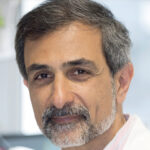Présentation
During tissuegenesis, muscle stem cells generate phenotypically and functionally distinct embryonic and foetal myoblasts (1, 2). We used genetically modified mice and constitutively expressed the intracellular domain of Notch1 receptor (NICD) to block the commitment of mouse embryonic muscle stem/progenitor cells (3). These arrested cells continued to proliferate in spite of the absence of committed myoblasts and differentiated cells indicating that sustained Notch signaling is sufficient for their maintenance cell-autonomously. We then showed that these muscle stem/progenitor cells that were blocked in lineage progression in the embryo proceeded to the foetal stage and adopted a foetal identity. We uncovered a differential effect of Notch, whereby high Notch activity is associated with stem/progenitor cell expansion in the mouse embryo, yet it promotes reversible cell cycle exit in the foetus and the appearance of an adult muscle stem cell state. This is true also for normal adult muscle stem cells. We propose that active Notch signalling is sufficient to sustain an upstream population of muscle founder stem cells while suppressing differentiation. Significantly, Notch does not override other signals that promote myogenic cell fates during ontology where spatiotemporal developmental cues produce distinct phenotypic classes of myoblasts.

